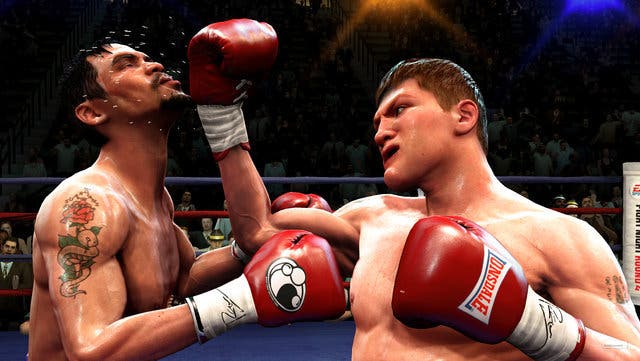Fight Night Round 4
Unconditional glove.
Every now and then it's fun to find a game that's not all about shooting men in the face. In times of extreme gun boredom, sometimes it's preferable to express your inner thug by turning to games where you simply batter men repeatedly with your fists until they fall over. Case in point: Fight Night Round 4, the follow-up to 2006's excellent man-battering sim, Fight Night Round 3.
Back in the days when we could get away with using terms like 'next-gen' without unruly gangs wanting to batter us to death, we breathlessly observed that it was “one of the greatest sporting spectacles we've ever been treated to in videogaming history".
But this was no idle hyperbole. Released to blanket acclaim, FNR3 offered an early look at what might be possible with new console technology. The obvious allure of astonishing visual fidelity was backed up with deceptively deep gameplay - all of which put EA so far ahead of the competition that few have even bothered attempting to rival it since. Even EA itself failed to repeat the formula, and got royally smacked down onto the canvas by appalled critics when the cartoon-style Facebreaker limped out last year. Having lost the plot so badly with one promising-looking boxing title, could this long-awaited sequel represent a welcome return to form?
The signs were certainly highly promising when Christian went to see the game during a recent hands-on session. Assurances were plentiful: solid 60 frames per second action, deeper, more tactically oriented gameplay, increased speed and fluidity, better punch collision detection, on-the-fly animation, and a much deeper career mode with a larger roster of fighting legends - and these were just the headline improvements.

As usual there are numerous ways to play the game, from one-off bouts to the more expansive slow-burn thrills of the game's 'Legacy' career mode. For those of you who just want to dive in, pick a boxing legend and create your own fantasy face-off, it's a boxing fan's dream. All the true greats of the modern age feature, allowing you to settle those pointless arguments about whether so-and-so was better than wotsisface. The 48-strong roster of real-life pros has a great selection of crowd pleasers across its eight weight divisions, including Ali, Foreman, Haglar, Leonard and Tyson mixing it up with modern favourites such as Calzaghe and Hatton.
If you prefer you can go in and create your own fighting machine, either from presets and sliders, or put yourself at the mercy of the game's attempts to map your face via webcam or an uploaded photo of your choice. Just as comically useless as the system utilised in Facebreaker, the end results end up barely even looking like you belong to the same species - but it's the thought that counts. Aside from cosmetics, you can also pick from numerous fighting and block styles, and fiddle around with stats to complete your creation. You can use your personalised bruiser in all areas of the game, from one-off bouts against real fighting legends to settling scores with your mates off and online.

Perhaps more interesting in the long run is to try and prove your worth in the Legacy career mode, where you can either choose an existing real-life violent hero or one of your own twisted creations. Taking this route puts you right at the bottom of the ladder as a young rookie, and your stats and abilities get well and truly neutered in the process - regardless of whether, like me, you picked Muhammad Ali, thinking foolishly that it might gain you a crafty edge.
Unlike with the forgiving early stages of FNR3's career mode, the sequel wastes no time in providing a stern challenge. Controls are broadly in line with the previous Total Punch Control system, with a combination of trigger commands and stick movements accounting for your upper and lower body movements, blocks and punches. As a system, the way it's laid out makes it easy to learn the basics - a variety of punch types are assigned to appropriate directions on the right stick, so punches are mapped to the side of the body you want to hit as well as mirroring where you want them to land. For example a blow to the left side of the head is achieved by pushing diagonally left, while a more powerful right hook involves pushing right then literally hooking the stick up in one swift motion. It takes longer to pull off, but the results are deadlier.


